|
|
|
The very peculiar horn shown below (it was dubbed "krazy horn" on one of the Internet
eMail horn lists when it turned up on eBay) is a result of E.A. Couturier's desire to
have a full
range of perfectly conical bore brass instruments. The horn in particular has throughout
its history been regarded as a "conical" instrument in comparison with the more cylindrical
trumpet branch of the brass family. In its purest form, the cor de chasse, the horn is
truly conical. With the introduction of tuning slides, first on the natural horn in the
eighteenth centruy and later on the valve tubing, the horn incorporated more and more
cylindrical "pockets" as Courturier calls them. In 1912 Couturier filed a patent applciation
for a fully conical cornet which is described at length below. This horn is an extension
of that patent. It can be readily seen that there are no tuning "slides" on the valves
as such. Instead the valve tubing is fixed having continuous conical taper. The taper is
maintained even within the bores of the pistons themselve. Free from the constraints of
parallel valve slide legs, Courturier was free to bend the tubing into seemingly whimsical
shapes, although his intent was no doubt to minimize the sharp bends found on more
common horn wraps. It doesn't appear that Couturier ever attempted a double horn design.
One can only wonder how that would have turned out!
The horn plays fairly well with a full range from the pedal notes to high C. The upper
register is sometimes weak and for some reason evan some middle range notes are poorly
centered. (Couturier addressed the problem of "wolf" notes in a later patent.) As noted below, the piston valves require almost twice the throw of rotary
valves adding difficulty to fast passages. Couturier became aware of this and purports
to have corrected it in his later patent (see below). Another issue is water removal. It
would have been nice if he had included water keys on the valve tubing which he does
show in the cornet patent drawings. Instead a careful combination of raising the bell
to drain the water back to the valves, then pressing the valves one at a time while
blowing forcefully to drive the water through to the first branch with a final full turn
of the horn to drain the water out the bell seems to be the most effective method.
(Another method might be to remove the valve pistons to drain the valve tubing but that
can only be done during long rests or tacets.)
|
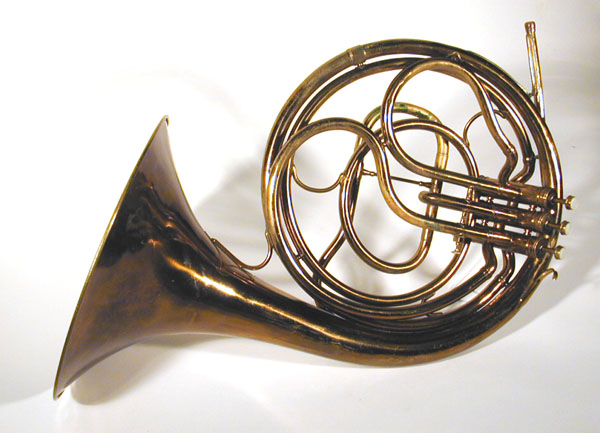
|
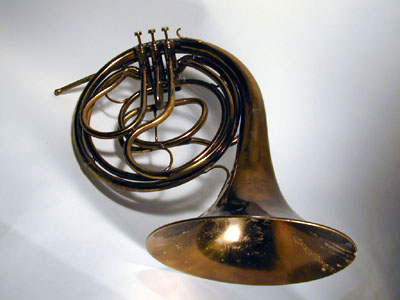
|
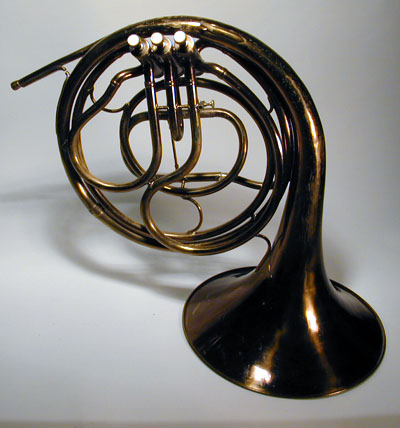
|
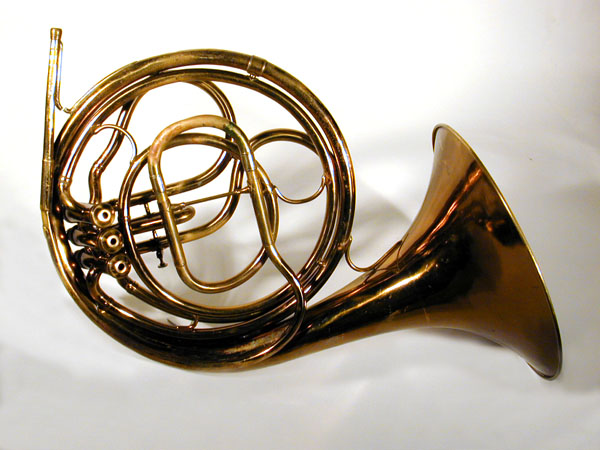
|
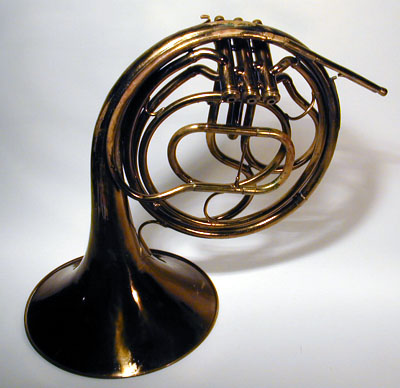
|
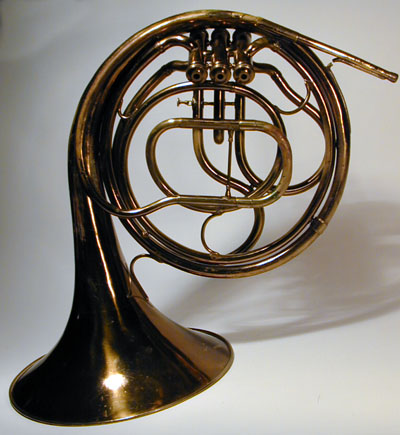
|
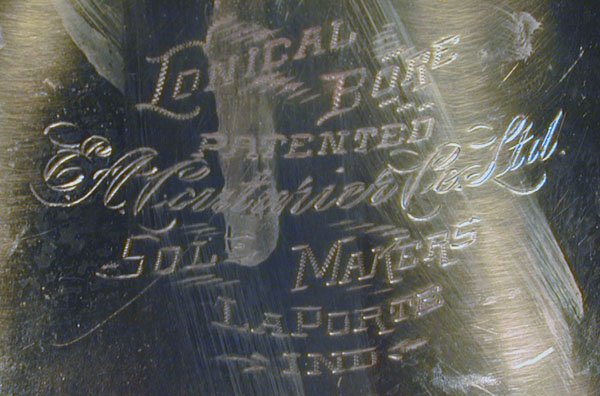
|
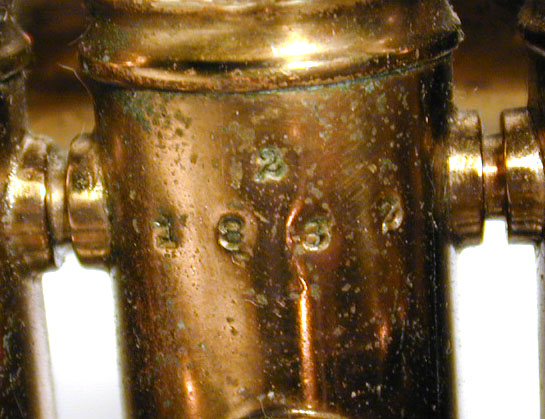
The serial number, 1882, is stamped on the second valve casing.
|
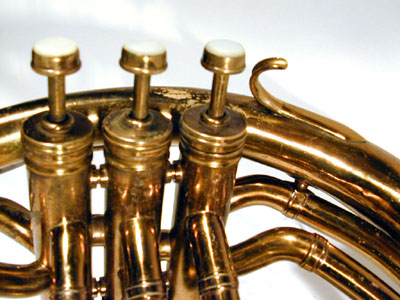 The valves are numbered 1,2,3 on the casings with
corresponding scratch marks on the bottom of the pistons.
The piston valve throw is about twice that of a typical rotary valve: Piston throw = 1.90 cm vs. .95 cm
on my Conn 8-D. Couturier addresses this problem in his "Wind Instrument patent of 1922. see details below.)
The valves are numbered 1,2,3 on the casings with
corresponding scratch marks on the bottom of the pistons.
The piston valve throw is about twice that of a typical rotary valve: Piston throw = 1.90 cm vs. .95 cm
on my Conn 8-D. Couturier addresses this problem in his "Wind Instrument patent of 1922. see details below.)
At right, in the top photo the pistons are shown in order from left to
right 1, 2, 3, as seen from the bell side of the horn and shown in the above photo.
In the lower photo they are in the same order but rotated 180o. (Note the
guide pin at the top of each piston. Note also that these pistons are sprung from the
bottom, and not the top as was shown in the original Conical Bore cornet patent of 1913
described in detail below.)
The pistons are conical-bored throughout to maintain the overall conical
bore of the horn. In his last patent "Valved Brass Instrument" (1,729,568, dated
September 24, 1929 and not used on these pistons), Couturier purported to eliminate
"wolf" notes by making the bore of the piston suddenly larger than the inbound port
diameter.
The piston diameter here is 1.98 cm. Couturier was later able to reduce this diameter in the second
generation of Conical Bore instruments by greatly shortening the length of the leadpipe
making the tubing diameter at the valves much smaller. (See patent 1,438,363 described in more detail, below.)
|
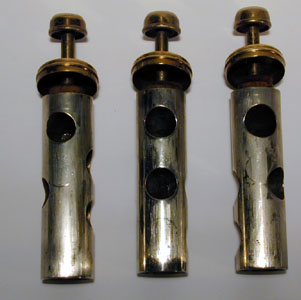
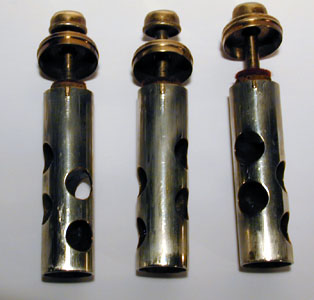
|
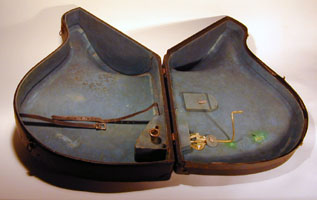
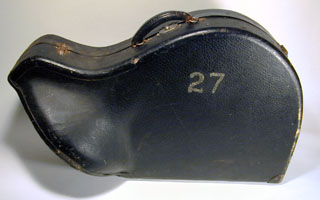
|
An open and shut case. Nothing unusual to report here except it appears to be contemporary
with the horn, smells pretty bad, and is labelled number 27, presumably one of a whole school fleet of Couturier
instruments. Now that would be something to hear! The mouthpiece is a Vincent Bach Corp., Mt.
Vernon, NY number 10, which barely fits the smallish mouthpipe receiver. In his efforts
to achieve maximal conicality, Couturier seems to have started with the smallest usable
mouthpiece receiver diameter. Case closed.
|
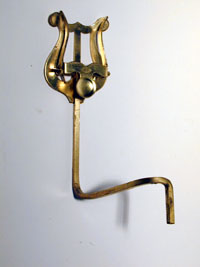
|
Last but certainly not least, the horn comes complete with a music lyre in case you haven't
fully memorized the "Long Call" for the halftime show. Couturier's placement of the lyre
holder requires the long stem variety with multiple bends.
|
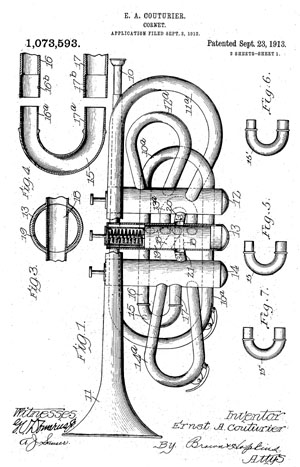
|
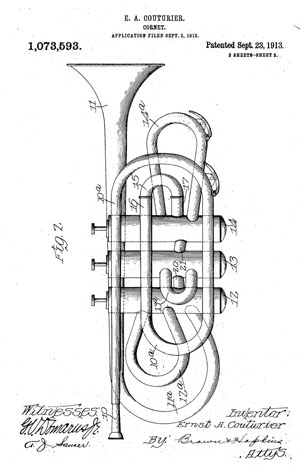
|
Couturier filed his first patent application for Conical Bore brass instruments (1,073,593,
accompanying illustrations shown above) on September 3, 1912. This is the patent that covers
the subject horn. In the application Couturier makes the following statements. (Numbers in
the text refer to the drawings shown above):
To produce the most desirable tone from a cornet it is essential that the vibration produced
the mouth piece be conveyed to the bell of the instrument through a constantly enlarging
pipe, and it is a detriment to the cornet now in use that they have, intermediate the mouth
piece and the bell, a number of cylindrical portions of the pipe. In order to produce the
most desirable sounds from a cornet I provide that the pipe through which the virbrations
produced at the mouth piece pass shall be constantly expanding from the mouth piece to the
bell, this expansion to be present whether the instrument is used in the well known open
position or with any combination of the valves.
...It is at times necessary to alter the number of vibrations produced by the cornet in
order to adapt it to the exact pitch of other instruments. This is done in the ordinary
cornets by lengthening the pipe through which the vibrations pass and this lengthening is
accomplished by pulling out, as far as necessary, U-shaped slides forming parts of the
pipe of the instrument. The ordinary cornet has such slides, both on the valve pipes and
on a section of the pipe through which all vibrations must pass whether the valves are
in use or not. The pulling out of these slides leaves cylindrical pockets in the pipe
which are detrimental to the quality of tone produced from the instrument. For tuning the
instrument I provide that an approximately U-shaped section 15 [note: ref. drawing above]
of the pipe thereof intermediate the mouth piece and the valve casing be removable and
when it is desired to lengthen the the pipe for varying the pitch I provide a longer
section 15', shown in Fig. 6, of a shape similar to 15 and interchangeable therewith,
or, should it be desired to shorten the pipe, I provide a shorter section 15'' shown in
Fig. 7 similarly shaped and interchangeable with section 15. The long section is of
such length as to lower the pitch of the cornet one-eighth of a tone or less and the
shorter section is so constructed as to raise the pitch one-eighth of a tone or less;
thus the cornet is given the range of one-quarter of a tone or less. By this interchange
of members I avoid the interposition in the pipe of any cylindrical portion adjacent the
member 15. This appears more clearly in Fig. 4 in which the gradual expansion of the pipe
is somewhat exaggerated. 16 is a portion of the mouth pipe as it comes to the member
15 from the mouth piece of the instrument; 17 is that portion of the the mouth pipe
nearest the bell from member 15. The end 16a of the member 15 is adapted to be
sheathed in the slightly enlarged inner portion 16b of the pipe of the
instrument and the end 17aof the member 15 is adapted to be sheathed into the
slightly enlarged inner portion 17b of the pipe 17. When these two ends are
respectively sheathed, the continuity of the pipe of the instrument remains unbroked,
while it would be possible to partially withdraw the member 15 from its full engagedment
with the portions 16b and 17b of the pipe and thereby vary the
pitchof the instrument, it is a fact that such action would impair the tone produced by
interposing in the pipe 2 cylindrical pockets. It is to avoid the forming of any such
pockets that I provide for tuning by means of a plurality of members similarly shaped to
member 15, of varying lengths, and interchangeable therewith.
It is important to note that the subject horn is NOT provided with additional slides
for fine tuning and that the legs of the main tuning slide appear to be cylindrical
throughout. In the cornet described above the taper is maintained throughout the tuning
slides by varying the thickness of the walls of the slide legs keeping the outer surface
cylindrical. On the subject horn the
slide legs are much longer and the wall thickness appears to be constant. Therefore the
conality of the subject horn is compromised by having two cylindrical "pockets" on the
tuning slide.
|
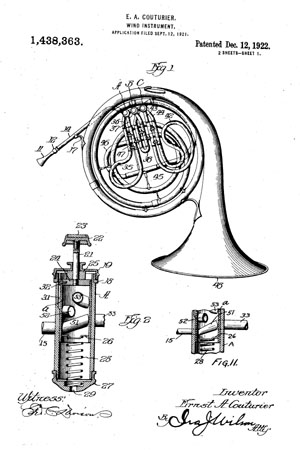
|
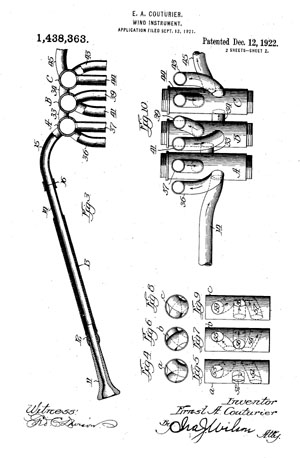
|
On September 12, 1921 Couturier applied for a second patent on his line of
Conical Bore instruments, this time illustrating it with the horn shown above. Note
the inclusion of conventional looking tuning slides on the valves. Couturier asserts,
however that "a continuously tapered conical bore is provided throughout the
length of the instrument." The main feature
of the new design was to shorten the mouth pipe such that the tubing at the valve
section is much smaller diameter than previously, thus allowing the valve pistons to
be of smaller diameter and length, reducing the length of the stroke, and
friction and mass to make the action faster.
This invention relates in general to wind instruments and more particularly to valved
instruments, and while the principles thereof are applicable to many types of instruments
such as orchestra horns, ballad horns, cornets, trumpets, fluegel horns and alto horns,
I have selected for illustrative purposes a French horn in which the principles of my
invention are embodied, as will be later understood.
In instruments of this character, it has heretofore been customary to employ a long
mouthpipe which in the ordinary French horn is eighty inches or more in length before
it enters the first valve chamber. Obviously, an appreciable amount of time is required
for the sound wave produced at the mouthpiece to travel through the mouthpipe to the
valve chambers, and consequently, if the valves are manipulated simultaneously with the
production of the desired tones at the mouthpiece, the control of the tones by the valves
will not be properly timed with respect to the production of the tones and therefore the
resultant tones delivered from the instrument will be more or less imperfect. This lagging
of the sound waves between the mouth piece and the valves can be somewhat corrected by
an experienced player, who from long practice, is able to partially compensate by his
fingering of the valves for the inherent inaccuracies of the instrument, but even prolonged
practice is unable to wholly overcome this defect. Another disadvantage of the ordinary
instrument of this character resides in the fact that by reason of the long mouthpipe the
ports or passages through the valve casings must be of considerable size, since the
diameter of the bore of the instrument increases with the increase of distance from the
mouthpiece. This large size of the valve passages necessitates a long stroke of the valve,
and in the ordinary French horn, if a piston valve (which is the most desirable of the
valves for this purpose) is employed, a stroke approximately three-fourths of an inch in
length is necessary to completely change the position of the valve passages with respect
to their communicating pipes. Obviously, such a long stroke is very tiresome for the
player, and in rapid work it is almost impossible of attainment. If a valve is only
partially depressed, as it is very apt to be when speedy manipulation of the valves is
required, the partial registration of the valve passages with connected pipes inevitably
results in an imperfect tone.
With a view of obviating such long strokes, it has been the practice to utilize rotary
instead of piston valves, and while these valves may be manipulated with a shorter stroke,
their action is sluggish and the liability of imperfect tones is not very materially
reduced by their use. Furthermore, if all metal operating mechanism is used, the parts
will rattle and cause an objectionable clicking when playing. If linen threads are used
in lieu of metal parts the threads are apt to break in the midst of a passage, thus
rendering the instrument useless as they cannot be quickly replaced.
Couturier goes on to explain in great detail how this new design overcomes these perceived deficiencies.
In a reply to a thread on horn@music.memphis.edu dated 9 March 2008 on the topic "krazy horn" in
reference to the subject horn, Steve Mumford offered the following information on the
horns made by E.A. Couturier including his own horn which is of the second design
described above:
The "improved" design was patented in 1922, patent # 1,438,363
if you'd like to look it up. It has tunable valve slides and a very short
leadpipe that goes directly into the 1st valve after only about 8 inches. This
means that the bore at the valve section is very small, the taper continues
through the valve section and after. This later design has a bigger bell throat
than the earlier one. Each tube of the valve section is slightly bigger when it
returns than when it goes out. For instance the "outbound" tube of the 2nd
valve is .358 and the "inbound" is .362.
Why wouldn't an "improvement" of this sort continue to be made? Money.
Manufacturers have learned to make acceptable instruments cheaply. There were
plenty of brass insturments built in the 20th century that had features that
really did make them play better, but they were more expensive to produce that
way. The Couturier brochure mentions that most piston valve brass instruments
required 2 different sizes of drills to drill all the holes in the valve
section. The Couturier instruments (everything from cornets to tubas) required
32 different drill sizes for the same operation.
So, why bother? Because it's there! Couturier wasn't just some random
nut. He was an amazing musician who could play things on the cornet that nobody
can play today. I'll extend a standing challenge - I have the music! He built
a company that produced the full range of brass instruments and also saxophones.
All the brass instruments were made on the "conical bore" principal, even the
trombone. He had a dream and he made it happen.
So, how does it play? Very nice! Ergonomically it's a little weird, the
piston valves aren't so easy to manipulate. The sound is unique, very dark and
woodsy, particularly rich when compared to "normal" horns. That richness of
sound is what I particularly like about it. It's different from anything else.
The pitch is very useable from low F# all the way up to high C, the E and D at
the bottom of the staff are nice, maybe a touch higher than usual which is not
so bad. D in the staff works just fine on open. It took a little while to find
the center above the staff, she's a bit leaky, but once I found it, it rings out
nicely.
As far as the earlier model with the non-tunable valve slides, I tend to
think that wouldn't really be a problem, other than water dumping! The cornets
and trumpets play well in tune in either Bb or A, using the same fixed valve
loops for both keys. How can that be? Let's just say that the acousticians
can't explain everything. Hmmm, now that I'm warming up to this thing I'm
liking it better and better. High range is really coming in, a little long
call, Konzertstueck etc. It opens up good for the louder stuff. Mendelssohn
Nocturne, very easy, relaxed, less taxing than on a double horn! I imagine this
would be a really nice horn if it wasn't quite so old, beat up and leaky!
- Steve Mumford
[Steve Mumford is a graduate of the University of Michigan School of Music. After
performing for eight years with the Louisville Orchestra, he returned to Ann Arbor
and is now a busy freelancer, appearing regularly with the Michigan Opera Theater
Orchestra and other orchestras around the Midwest. He has toured the country presenting
lecture-recitals on the history of the horn. Mr. Mumford has played antique instruments
with baroque orchestras in New York and Los Angeles and has performed on original Civil
War instruments for PBS's The Civil War series.]
|

















